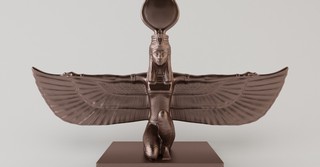Should We Still Be Wary of "Graven Images"?
Share

“Graven images” isn’t a phrase we typically use in everyday conversation. However, many of us probably recognize it as part of the Ten Commandments, where they are forbidden.
Exodus 20:4, in the King James Version, states, “Thou shalt not make unto thee any graven image, or any likeness of any thing that is in heaven above, or that is in the earth beneath, or that is in the water under the earth.”
But what is a graven image? And is this something of which we still need to be wary?
Though graven images may not look the same for us today, the second commandment is just as applicable now as it was over three thousand years ago.
Photo credit: ©Getty Images/Helin Loik-Tomson
What Is a Graven Image?

The Hebrew word (roughly Romanized to “pesel”) that is translated to graven image in Exodus 20:4, might also be translated as “idol” or “image.” Judges 18:14 gives further context, differentiating between a graven image (pesel) and molten image (maccekah). Thus, a graven image was carved, as out of stone, wood, or metal, either a statue or a relief carving as on a wall or pole (like an Asherah pole).
Idols were common in the world around the Israelites. When God gave the Ten Commandments, the Israelites had just left Egypt, where the Egyptians worshiped dozens, even hundreds, of gods represented by idols. These idols were believed to hold the power of the gods.
Gods in the ancient Near East could be bloodthirsty. Canaanites were known to sacrifice children to Molech before his statue, while prophets of Baal slashed themselves to invoke the attention of their god. This is even referenced in the Bible, in 1 Kings 18:28.
Idols were often fashioned as humanoid figures, animals, or a mixture of both. Though it was acknowledged that idols were built by human hands, the gods, or at least portions of their power, were still believed to indwell them.
It is notable that when the Bible refers to these “graven images,” now usually translated as idols, it is specifically referring to objects of worship.
Though bowing down to a stone or statue may sound silly to a lot of us, this was a major problem for the Israelites. The King James Version of the Bible mentions “graven images” about 40 times.
Photo credit: ©Getty Images/giko
Why Is Idolatry So Important in the Bible?

A large part of idolatry was the attempt to exercise some control over circumstances. If a person could find the force that controlled a specific aspect of their life—for example, a farmer finding a rain god—a person could build a temple and offer sacrifices in order to appease and persuade the god to act in a favorable manner. Talismans could be crafted to offer protection and household idols were placed to bring blessing to the family.
The gods were usually considered tempestuous and unpredictable, but through rituals, charms, and other means, worshippers gained some sense of control and security.
Considering idolatry was the prevailing religion of the day, it is no surprise that this was a major problem God had to address with the Israelites over and over again.
Though it is impossible to state exactly what drove an individual Israelite to idolatry, the allure throughout Israel’s history proved irresistible for many. Perhaps it was the convenience of giving sacrifices to idols to get what they wanted rather than giving over their lives to the service of God. Perhaps it was the illusion of control. It was certainly sometimes due to peer pressure; kings such as Solomon and Ahab allowed idolatry to grow and fester in order to appease their foreign wives.
Unlike the pantheons of other religions, the Lord refused to be one of many gods. He claimed to be the only God, and He would not share His glory. Deuteronomy 6:4-5 instructs, “Hear, O Israel: The Lord our God, the Lord is one. Love the Lord your God with all your heart and with all your soul and with all your strength.” Idolatry stole the glory and honor that belongs solely to God.
Photo credit: Unsplash/Ben White
God Cannot Be Contained

Another part of the allure of idolatry was the ability to see the gods. A person could bow down to a physical statue or carry a physical talisman. But the Lord refused to be reduced in such a way. The Lord is “the King eternal, immortal, invisible” (1 Timothy 1:17). When Aaron built the golden calves for the Israelites to worship as God in the desert while Moses was busy communing with God on Mt. Sinai, Moses and God were so incensed that Moses ground up the calves and forced the Israelites to drink the powder (Exodus 32:20). The Lord then ordered three thousand put to death (Exodus 30:28). It is foolish to believe that the God of all the universe could be contained by any earthly object.
By the time of Jesus and the early Christians, the Israelites (now called the Jews) no longer struggled much with worshipping physical idols. After their rampant immorality and idolatry led to the fall of Israel and Judah and years of foreign captivity, Judaism became solidified and the Law more strictly enforced. However, idolatry is still discussed in the New Testament. Without “graven images,” how is this possible? We’ll explore that below.
Is This Verse and Commandment Still Relevant Today?
Jesus said, “Do not think that I have come to abolish the Law or the Prophets; I have not come to abolish them but to fulfill them” (Matthew 5:17).
The command against graven images, or idols, still holds true, though it may be applicable a little differently today.
When the New Testament speaks about idols, it isn’t necessarily about statues or altars. Instead, idols are anything that a person puts before God in importance in their life.
Colossians 3:5 states, “Put to death, therefore, whatever belongs to your earthly nature: sexual immorality, impurity, lust, evil desires and greed, which is idolatry.”
An idol is anything we put our trust in that is not God. In Judges 10, the Israelites abandoned God and worshipped idols. Then, when trouble came, they finally cried out to God. But God said, “Go and cry out to the gods you have chosen. Let them save you when you are in trouble!” (Judges 10:14). In this instance, they repented, aware that their idols could not help, and God delivered them. Like the literal idols in Judges, our idols are things we believe might save us — until they fail.
Photo credit: Unsplash/Wang Xi
What Are Some Examples of Modern "Graven Images"?

Some people even today worship graven images in statue form. Others might place trust in objects like talismans or charms. These are easy to recognize.
However, for many of us, our idols are harder to spot. They become easier to find if we ask ourselves, “What do I depend on for safety and security?”
Is it money? Our jobs? Our own physical health? All of these things can fail.
Though there is nothing wrong with having money, jobs, health, or any other good things, they become problematic when we depend more on them than on God.
We can also ask ourselves, “What is most important to me?” Is it fame? A hobby or career? Money? Power? Food? Relationships? Then we must ask ourselves if we have placed more importance on these things than on our relationship with God. Would we be willing to give them up if the Lord asked?
Idols today are just as tempting as they were to the Israelites. When we read about idols and graven images, let it remind us to place God above all else in our lives, and worship Him alone.
Photo credit: ©Getty Images/Deagreez
